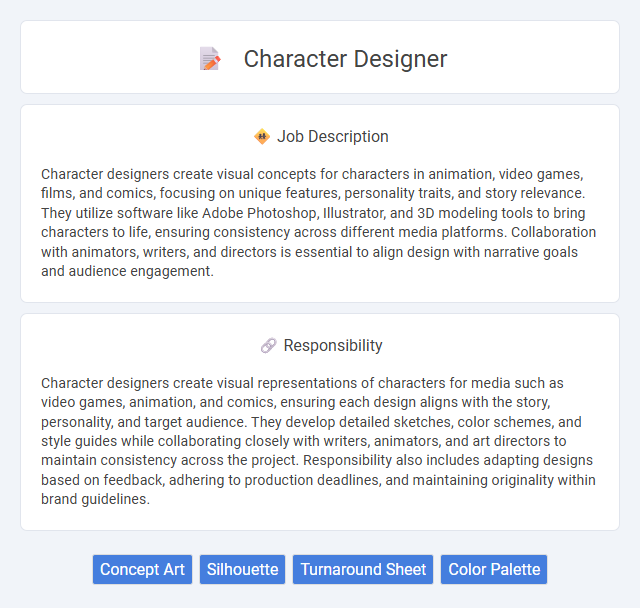
Character designers create visual concepts for characters in animation, video games, films, and comics, focusing on unique features, personality traits, and story relevance. They utilize software like Adobe Photoshop, Illustrator, and 3D modeling tools to bring characters to life, ensuring consistency across different media platforms. Collaboration with animators, writers, and directors is essential to align design with narrative goals and audience engagement.
People with a strong passion for art and storytelling are likely to find character design a rewarding career, as it requires creativity and attention to detail. Those who thrive in collaborative environments and can adapt to client feedback may be more suited to the dynamic nature of this job. Individuals lacking patience for iterative work or struggling with tight deadlines might find the demands of character design challenging.
Qualification
Character designers must possess strong artistic skills, including proficiency in drawing, digital illustration, and 3D modeling software such as Adobe Photoshop, Illustrator, and Blender. A background in animation, graphic design, or fine arts combined with a solid understanding of anatomy, color theory, and character development is essential. Experience with storytelling techniques and the ability to create unique, memorable characters that fit specific narratives or brand identities enhances a candidate's qualifications.
Responsibility
Character designers create visual representations of characters for media such as video games, animation, and comics, ensuring each design aligns with the story, personality, and target audience. They develop detailed sketches, color schemes, and style guides while collaborating closely with writers, animators, and art directors to maintain consistency across the project. Responsibility also includes adapting designs based on feedback, adhering to production deadlines, and maintaining originality within brand guidelines.
Benefit
A career as a character designer likely offers creative fulfillment through the opportunity to bring unique characters to life visually. This job probably provides exposure to various industries such as animation, gaming, and advertising, enhancing professional versatility. Financial stability may also be achievable, especially with experience in high-demand markets or working on popular projects.
Challenge
Character designers likely face the challenge of balancing creativity with client expectations, requiring them to produce unique yet practical designs that align with project goals. They probably need to adapt to evolving trends and technologies, which can demand continuous learning and flexibility. The pressure to develop visually compelling characters that resonate emotionally with audiences may also create ongoing creative challenges.
Career Advancement
Character designers develop unique visual concepts for animated films, video games, and graphic novels, combining artistic skill with storytelling. Mastery of digital illustration tools and deep understanding of anatomy and culture enhance career growth opportunities, leading to roles such as senior character designer or art director. Networking within creative industries and building a diverse portfolio accelerates advancement in this competitive field.
Key Terms
Concept Art
Character designers specializing in concept art create visually compelling and original characters that align with the narrative and artistic vision of games, films, or animations. They use advanced skills in anatomy, color theory, and software like Adobe Photoshop and Blender to develop detailed character sketches and turnarounds. Their work facilitates collaboration across art and production teams, ensuring characters are both aesthetically appealing and practically designed for animation or digital rendering.
Silhouette
Character designers use silhouette shapes to create instantly recognizable and visually striking characters that communicate personality and role at a glance. Mastery of silhouette ensures that characters remain distinct and easily identifiable even in low-detail or shadowed scenes, enhancing storytelling effectiveness. Strong, clear silhouettes contribute to visual harmony across different character designs within a project, reinforcing brand identity and audience engagement.
Turnaround Sheet
A Character Designer creates detailed Turnaround Sheets that showcase multiple views of a character, including front, side, and back poses, ensuring consistent representation across animation and production stages. These sheets incorporate precise proportions, facial expressions, and costume details to guide animators and 3D modelers effectively. Mastery in software like Adobe Photoshop or Toon Boom Harmony enhances the clarity and usability of these essential design references.
Color Palette
Character designers use color palettes strategically to convey personality, mood, and narrative context through hues, saturation, and contrast. Selecting complementary and harmonious colors enhances visual appeal while supporting character traits and storytelling elements. Mastery of color theory and trends ensures the palette aligns with the project's aesthetic and audience expectations.
 kuljobs.com
kuljobs.com